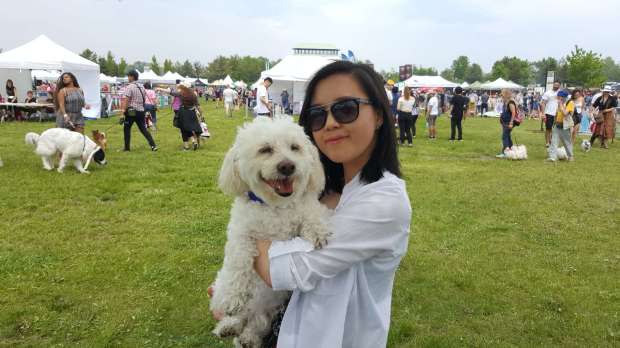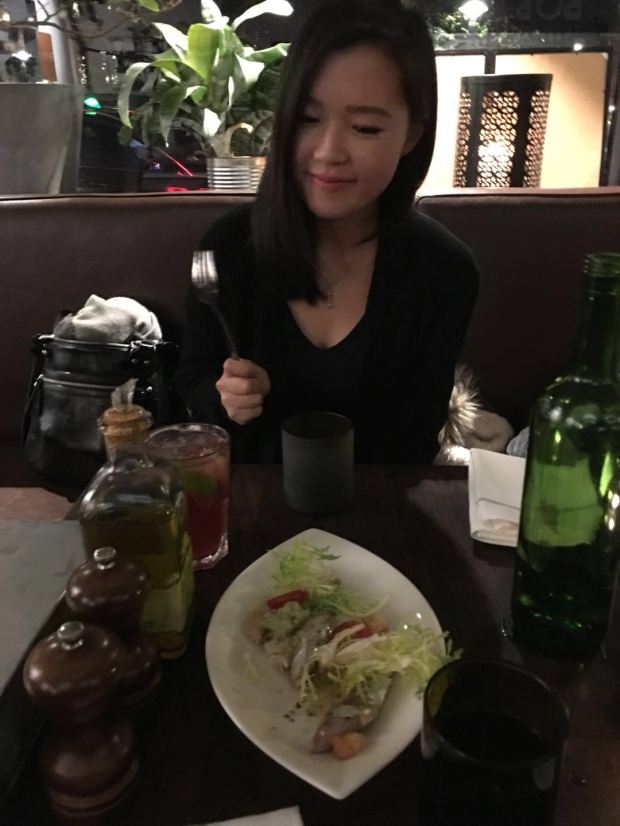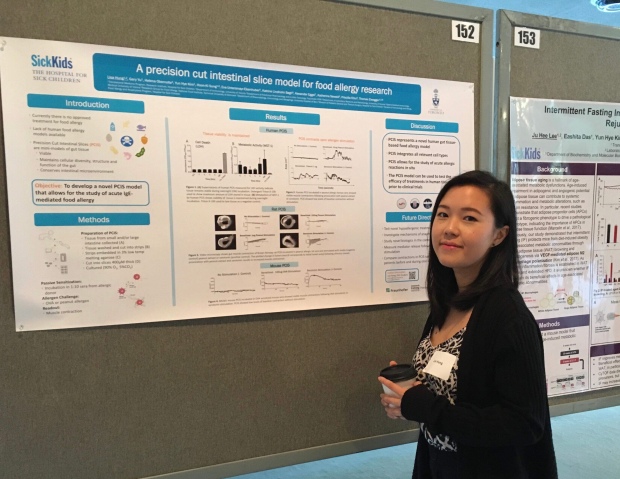 PhD student & food allergy researcher, Lisa Hung, was first diagnosed with food allergies when she reacted to rice cereal at only 6 months of age. In her 24 years, Lisa has been hospitalized for anaphylaxis upwards of 20 times — mostly due to her milk allergy. While life has been challenging to say the least, Lisa has made every effort to see the silver lining and make a difference: from volunteering for allergy organizations, to mentoring children with food allergies, to acting as Co-President of the Immunology Graduate Students’ Association (IGSA), to joining the Top 10 Challenge committee, to organizing inclusive events, this young researcher is unstoppable!
PhD student & food allergy researcher, Lisa Hung, was first diagnosed with food allergies when she reacted to rice cereal at only 6 months of age. In her 24 years, Lisa has been hospitalized for anaphylaxis upwards of 20 times — mostly due to her milk allergy. While life has been challenging to say the least, Lisa has made every effort to see the silver lining and make a difference: from volunteering for allergy organizations, to mentoring children with food allergies, to acting as Co-President of the Immunology Graduate Students’ Association (IGSA), to joining the Top 10 Challenge committee, to organizing inclusive events, this young researcher is unstoppable!
AllergyBites: What foods are you allergic to?
Lisa Hung: Milk, peanuts, and tree nuts. All very severe and anaphylactic!
AB: Can you describe the first time you truly understood you had food allergies because they impacted your life in a meaningful way?
LH: I’ve never known a time I was not severely allergic to many foods, I’ve just always been a person with allergies. I don’t remember my first reaction, but I remember the multitude of times I was in and out of the ER for eating something I shouldn’t have (all normally edible foods!). My allergies encompass whole food groups (dairy, I’m looking at you) especially in the western diet, so the majority of popular foods are off the table for me. To be honest, my allergies affect every aspect of my life in some way, but many of those are positive so there’s a lot to be grateful for!

AB: Have you ever experienced an anaphylactic reaction? If yes, what happened?
LH: Yes, so many times. I’ve definitely lost count. The last anaphylactic reaction I experienced was last year at Starbucks after using the soy milk canister, which I strongly suspect did not hold soy milk after all. The first symptoms are generally itchiness in the mouth, throat, and hands, followed by redness, hives, swelling of the hands and face, and a strong feeling of dread. I usually use my EpiPen and find the nearest hospital shortly after the initial symptoms. The list of foods I’ve reacted to are vast and varying, from hot dogs to oatmeal.
AB: How were your parents when it came to letting you participate in everyday activities?
LH: My parents are amazing. They never ever let me feel like I was missing out on anything. My mom especially went out of her way to chaperone events as often as possible when I was in elementary school so her presence would reassure me. She would always pack lunch for me and try to recreate foods that I couldn’t eat in order to show me I wasn’t missing out. Now, she trusts that I’m able to make informed decisions on what I’m eating. She never really held me back from participating — if anything she tried to engage as much as she could to educate others and expand my circle of care.

AB: In retrospect, is there anything you wish your parents had done differently?
LH: I think my parents often feel personally responsible for my allergies and how they handled it back then. But to be fair, the scientific knowledge on food allergies is vastly different now, compared to then. When I was born, pediatricians told parents to delay introduction to foods they considered allergenic (e.g., peanuts), but we now know that this delay may actually increase the risk and susceptibility to developing an allergy. The current practice is actually to introduce peanuts into the diet as early as 4-6 months of age. So while it’s easy to say “you should have done this,” it’s not a fair statement considering experts in the field at the time were telling parents to behave a certain way based on the evidence available. So no, I don’t wish my parents had done anything differently as it led to where I am now, trying to expand our scientific knowledge on food allergies.
AB: Have you ever thought about what your parents’ grieving process looked like? Do you think they ever reached the “acceptance” phase?
LH: I often think about what it must have been like for my parents as new immigrants, having to adapt to a different language, culture, and country — and on top of that, having two infants with severe, life-threatening food allergies. It must have been very overwhelming. I have spoken about this experience with my mom at length, and she tends to come back to certain points as being the most difficult. Mainly, she found the incidence of food allergies to be rather rare when we were diagnosed, so she wasn’t previously exposed to the possibility that this could even happen to her children. Additionally, the general population wasn’t very aware of food allergies, and because she also wasn’t that familiar with western cuisine at the time, I often reacted to foods because no one knew exactly what was in them! So while I can imagine my mom went through the initial “stages of grief,” as any parent would, she isn’t really one to dwell on misfortune of any kind, but especially something you can’t control or fix. Due to this, she quickly came to terms with the fact that we had allergies, and just did her best to raise us as normally as she could.
AB: As someone who grew up with food allergies, what’s the #1 tip you’d like to share with other parents trying to keep their little ones safe?
LH: The #1 tip has to be education. I honestly believe most people (food providers, other parents, caregivers, etc.) want to keep your children safe as best they can, but they just don’t have the knowledge or tools available to do this. The best thing you can do as a parent of a child with food allergies is to educate people on the severity of the situation, as well as how they can help. It really just takes small steps for greater awareness: telling your extended family how to keep holidays safe, communicating to other parents how to keep playdates allergy-friendly, asking restaurant owners about food allergy policies, etc.
In addition to this, personal education is also crucially important. There are constantly new studies about food allergies being published that further illuminate the complexities of this disorder. These ultimately go on to influence changes in health care policies and guidelines that can affect the allergy status of your child. Keeping yourself informed on these changes and maybe even reading lay-summaries of these studies may help you to better understand food allergies in general, potential treatment options for your child, or early prevention strategies for children who are at risk of developing an allergy (if a sibling is already allergic).

AB: Any tips for young adults navigating life with food allergies?
LH: I would urge my peers to join as many food allergy groups as possible. It may seem overwhelming at first, but there are so many people out there going through the same things as you. These people are great resources to talk to and learn from. It’s not easy to make yourself try new foods or go to a potentially dubious restaurant, but surprisingly, there are incredibly brave people out there that will make these ventures and are more than happy to tell you all about their experience. Find a group and make some “allergy friends.” It’s easier to live with food allergies with a strong support system. It can be really hard sometimes to navigate the world when it feels like no one understands what you’re going through… but there are people that do, and you should try to find them. If no one else, feel free to contact me!
AB: What were your biggest challenges as a ‘food-allergic kid’? Now that you’re all grown up, have those challenges evolved?
LH: It’s crazy how large a role food plays in general social interaction. I was shockingly aware of this as a child, and continue to be as an adult. Specifically, during childhood many of the events outside of the classroom involved food. These included bake sales, food-themed days, birthday parties, etc. Even in the classroom, prizes would be largely food-based and lunches were often eaten in a small, enclosed space. As much as my mom tried to make me feel included, it was obvious that I was “different.” I believe allergy policies have been greatly improved since I was in elementary school, which I am incredibly thankful for, but my mother was one of the first parents to ask for a peanut-free classroom at my school (and she had to fight so hard to win that battle at the time). Still, the presence of my allergens wasn’t the hardest challenge (though it didn’t help) since I understood — even as a child — that eating certain foods would make me sick. The real challenge was the fact that no one else seemed to understand or care about the severity of the reaction if/when it occurred. Like all children, there was some aspect of bullying at school but it was made even easier for them since all they had to do was rub Cheetos on my face (true story).

Unsurprisingly, food-centric events are not uncommon as an adult. In fact, they’re possibly even more apparent since I no longer have my parents or teachers providing a “safe zone” for me. I now face similar challenges, on a slightly larger scale. Although food allergy awareness is much better than it used to be, I would say a large proportion of food providers still do not understand the fundamentals of food allergy. It is exhausting trying to explain over and over that yes, butter is made of milk, and yes, it is essentially poison to me. In Canada, I find I’m at least able to explain my situation and they understand to some degree what it is I’m trying to convey. However, my research has taken me to Europe on several occasions, where it is much more difficult to communicate this concept (particularly in non-English speaking countries or in places where the definition of “allergy” isn’t as serious as it is back home). My allergies have given me many challenges to face both as a child and as an adult — it’s difficult for sure — but there’s always some way to resolve the situation, and my experiences have made me a stronger person in the end.
AB: How often do you eat out?
LH: I never really used to be a big fan of eating out, but I’ve (fairly) recently been more adventurous when it comes to going to restaurants. My boyfriend has been a really great support system and a large part of why I feel comfortable doing so. I would say I eat out about once or twice a week now.

AB: Where are your go-to SAFE eating spots?
LH: I am completely comfortable eating at any Korean or Japanese restaurant. For the Korean places, I generally know what goes into the food — they don’t tend to use much dairy or nuts — although some more modern restaurants are starting to add in these ingredients (but it’s usually pretty apparent when they’ve done so). In Japanese places, sushi is always a safe bet — anything where I can see all the components of the food is the most comfortable way for me to eat out. In terms of restaurant chains, I find Swiss Chalet and Nando’s are great go-to’s.
AB: Can you tell me why Nando’s makes you feel safe?
LH: Swiss Chalet and Nando’s are great for the same reason: they both have really detailed allergy guides/menus that make it easy to see what food are off-limits. They both write your allergen on the receipt/food order as well so it’s clear they take it seriously.
AB: Can you tell us how your studies relate to food allergies?
LH: I’ve always had an interest in food allergy research, so I’ve shaped my education/career path to pursue this goal. I’m currently in the 3rd year of my PhD in the lab of Dr. Thomas Eiwegger, conducting food allergy research at the Hospital for Sick Children.

My thesis project is to generate a human tissue-based model of food allergy to be used for treatment development and to help us understand food allergies on a deeper level. We really don’t know very much about food allergies as a whole. Any presentation on the topic further illustrates just how much we don’t know as the answer to most questions are “it’s too soon to tell” or “we are currently pursuing that research topic.”
My project is attempting to provide some clarity on the cellular mechanisms that occur during an allergic reaction. Many cells involved in allergic reactions live in your tissue, which means studies that use blood samples are missing out on this important population. By using intestinal tissue that we can “make” allergic, we can look specifically at these understudied cell types, which may include new drug targets.

AB: Why did you decide to join the Top 10 Challenge committee as a volunteer?
LH: I strongly believe we can find a safe, effective treatment for food allergies within our lifetime — and the answer lies in research. The Top 10 Challenge is a great initiative that not only advocates for food allergy education and awareness, but also supports food allergy research. As a researcher I can definitively say that funding is our GREATEST impediment in scientific progress. It is important now, more than ever, to fund research in food allergies as the incidence is increasing globally.
The Top 10 Challenge is so creative and inclusive and I really wanted to play a role in its conception/foundation/establishment. The committee is full of warm, intelligent, amazing individuals that I’m also really proud and happy to have met and will continue to work with.
